How to use remarketing in Google ADS to increase conversions

- What is remarketing in Google Ads?
- How does remarketing work?
- What do I need to set up remarketing?
- Types of remarketing: how to choose the right one?
- How to set up a campaign correctly?
- What makes remarketing effective?
- Remarketing and customer psychology
- Why should you use remarketing today?
- (Bonus) Our Remarketing Examples: How It Works in Real-World Situations
In today’s digital marketing, remarketing has become one of the most effective tools for re-engaging users who have already interacted with your business but have not taken a targeted action. With the capabilities of Google ADS, remarketing allows you to set up spot ads that remind users about your products or services. This helps not only increase conversions, but also improve brand awareness, strengthening the connection with your audience.
In this article, we’ll look at the basic principles of remarketing, practical recommendations for setting it up, and share strategies that will help you make the most of this tool to achieve your business goals.
1. What is remarketing in Google Ads?
Remarketing in Google Ads is a powerful tool that allows you to bring potential customers back to your website or app and encourage them to take targeted actions. This could be a purchase, registration, form filling, or any other interaction that is important to your business. Imagine that you own a store. A person came in, looked at the product, but left without making a purchase. What can you do? In a physical store – nothing. But in the online world, Google Ads allows you to literally “catch up” with this customer and remind them of what they left on your website.
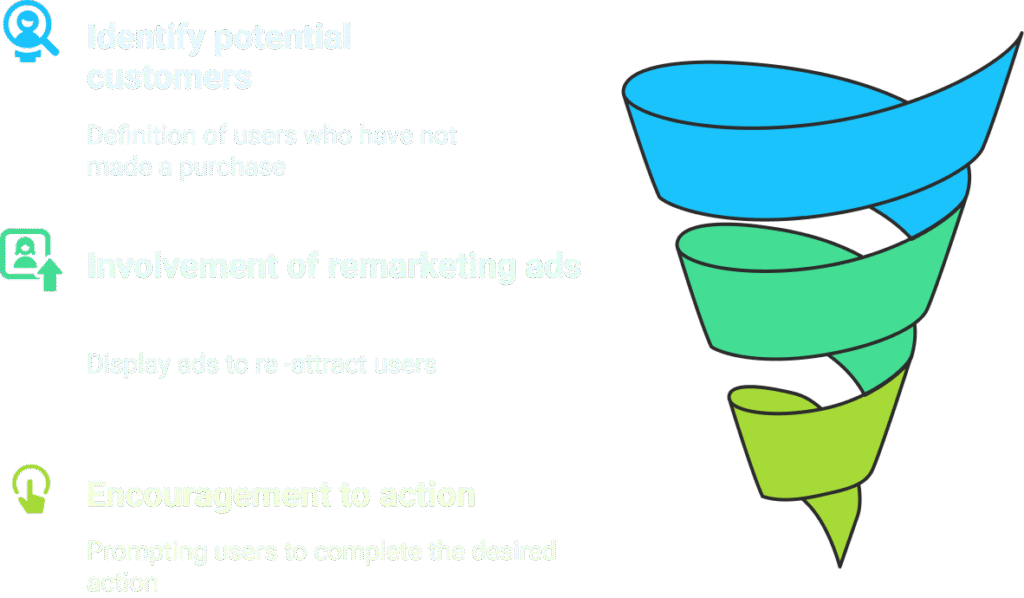
The idea of remarketing is based on understanding user behavior: people are not always ready to make a purchase on their first visit. They may need to think, compare, or simply be distracted. That is why remarketing is so effective. It helps you “keep your finger on the pulse” of your customer.
2. How does remarketing work?
The principle of remarketing is quite simple, although there are complex algorithms behind it. When a person visits your site, their browser stores a special cookie or sends a signal to Google Ads. This information allows you to create special audience lists. For example, you can collect those who viewed a specific page, added a product to the cart, or even performed a certain action but did not complete the process.
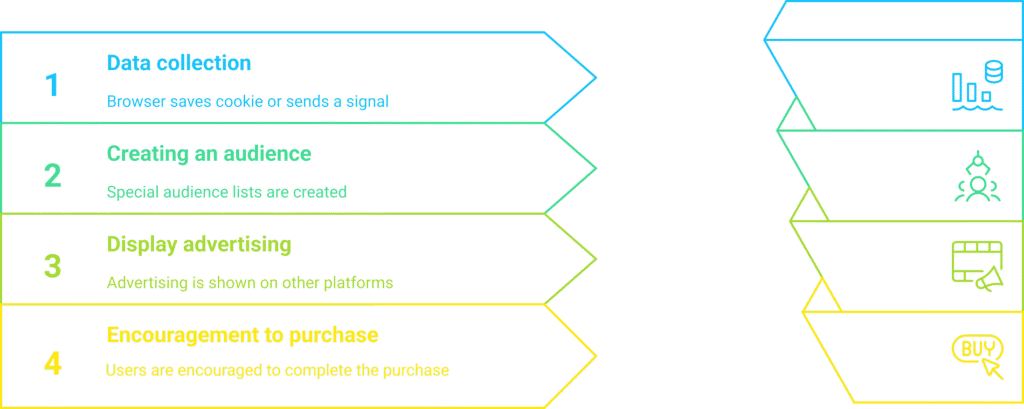
Let’s imagine a situation: a customer was looking at winter jackets in your online store. You set up remarketing so that this customer is shown ads for those jackets on other platforms – news sites, YouTube videos, or mobile apps. This way, it reminds them of your business, encouraging them to make a purchase.
It’s important to understand that remarketing isn’t just about “chasing” customers. It’s about being relevant. Showing ads at the right time and with the right offer.
3. What is needed to set up remarketing?
The first step in setting up remarketing is technical preparation. You need to add a remarketing tag to your website or integrate Google Analytics. This tag acts as a marker that captures user actions.
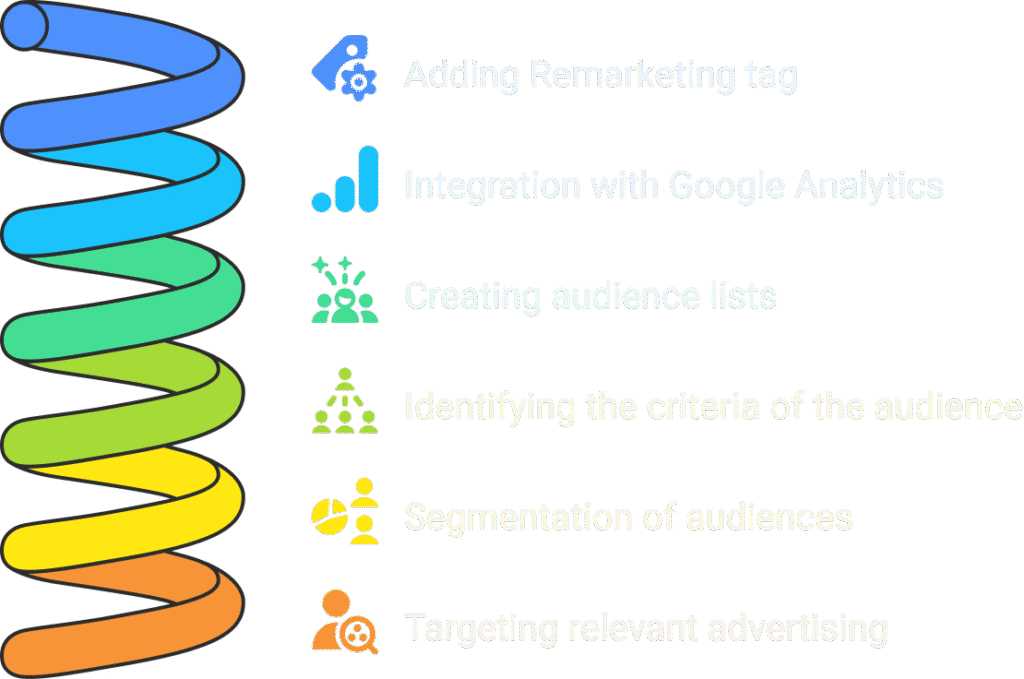
Next, you need to create audiences. In Google Ads, this is done through the “Audience Lists” section. For example, you can create a list of people who:
- I visited the site, but didn’t buy anything.
- Viewed specific pages.
- I added items to my cart, but did not complete the purchase.
These lists are the basis for remarketing campaigns. It is important to segment audiences so that each of them receives the most relevant advertising. For example, if a customer has already purchased a product, you should show them ads for related products, rather than reminding them about what they just purchased.
4. Remarketing Types: Choose What’s Right for You
Remarketing has several options, and each of them meets different business goals.
- Standard remarketing allows you to show ads to people who have already visited your site. It’s the easiest way to get noticed.
- Dynamic remarketing is a more personalized approach, showing users the exact products they viewed. This is ideal for online stores.
- Video remarketing targets people who have engaged with your videos on YouTube, and you can offer them more content or even special offers.
- Remarketing in mobile apps is suitable for engaging users who have downloaded your app but stopped using it.
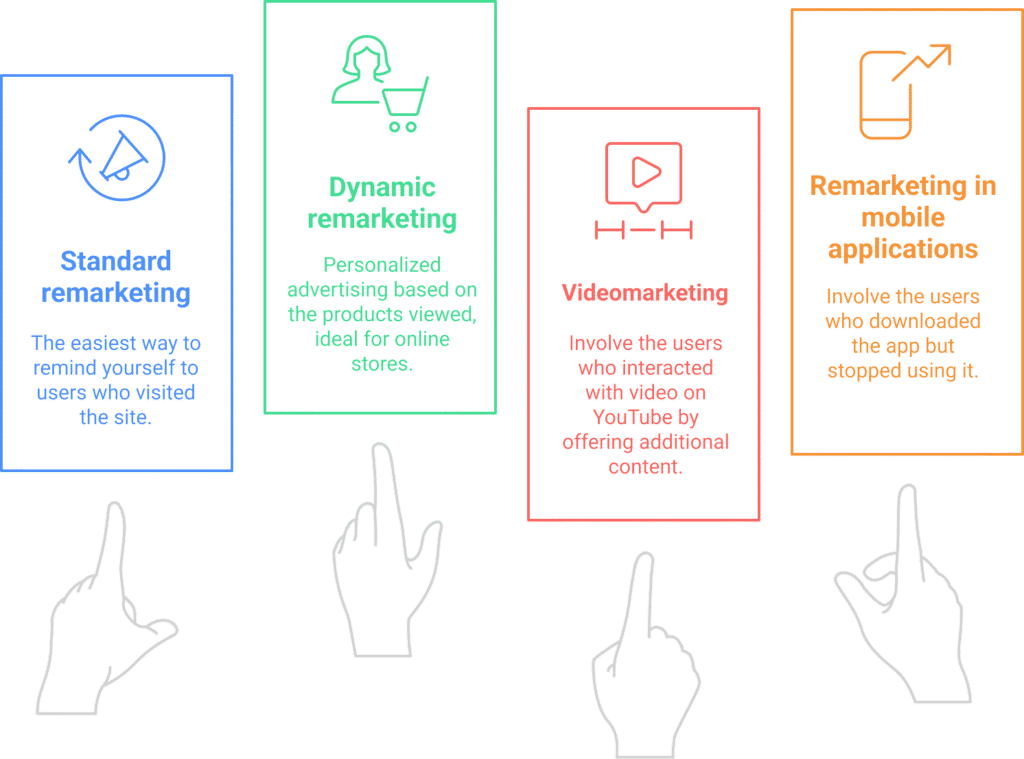
Each of these types has its own advantages, and the choice depends on your business objectives. If your business is e-commerce, dynamic remarketing can be a key tool. If you are developing a mobile app, you should focus on in-app remarketing.
5. How to set up a campaign correctly?
Setting up a remarketing campaign starts with a clear goal. You need to understand what you want to achieve: return customers, increase sales, or increase brand loyalty.
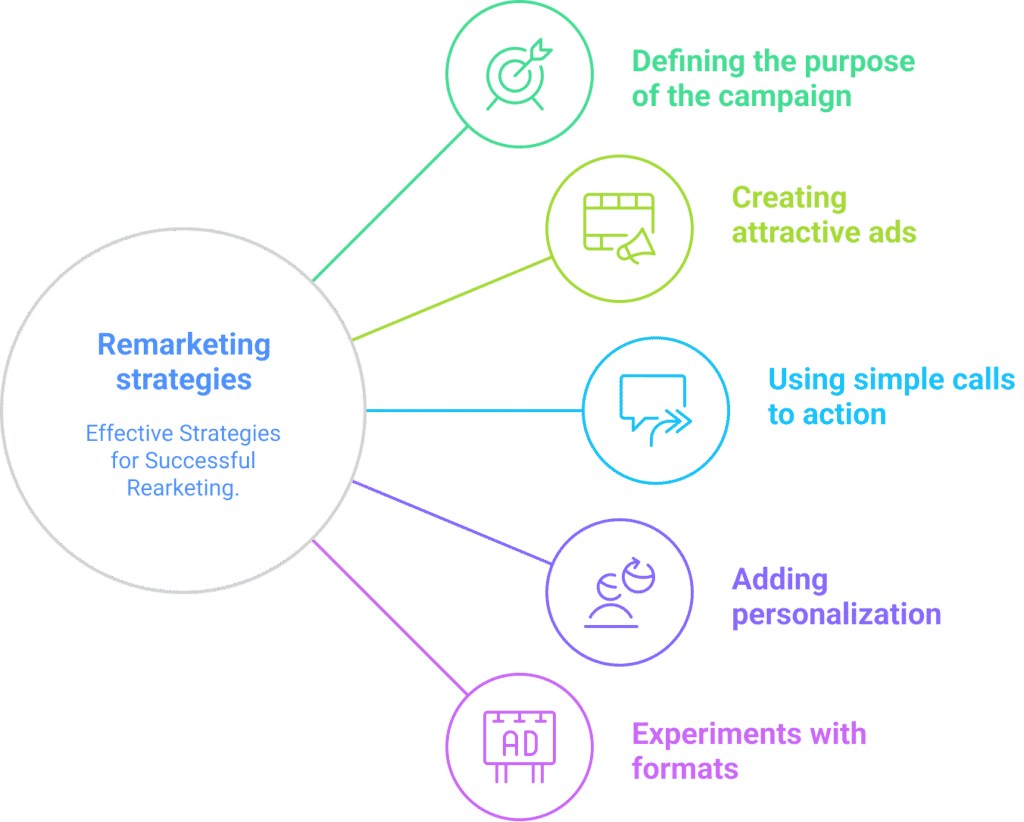
Next comes creating eye-catching ads. This is critical because your ad needs to stand out from the crowd. Here are some tips:
- Use simple and clear calls to action (CTAs). For example, “Buy Now” or “Get 20% Off.”
- Add personalization. If it’s dynamic remarketing, show products the user has viewed.
- Experiment with formats. Banner ads, video, text ads—they can all work.
6. What makes remarketing effective?
One of the key factors in remarketing success is segmentation. Not all users are the same, and not all of them need to be shown the same ads. For example, those who have only visited the homepage should see a more general ad that tells about your products or services. But those who have already added an item to their cart but have not completed the purchase need a specific motivation: a discount, a bonus, or free shipping.
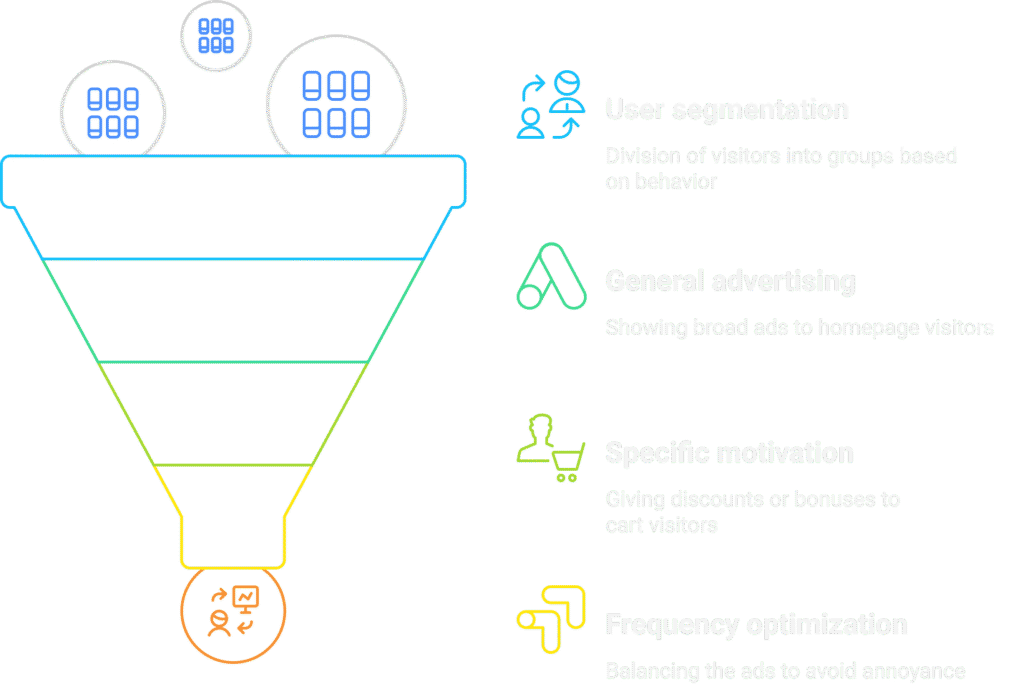
Another important aspect is the frequency of impressions. There is nothing worse than constantly harassing a customer with ads. This can be annoying and even harmful to your brand. The optimal frequency of impressions is one that reminds you of your product, but does not “press”.
7. Remarketing and customer psychology
Remarketing is based on the principle of reminders and creating a “brand familiarity” effect. People trust more what they have already seen. So even if they don’t buy the first time, each reminder strengthens your brand’s position in their minds.
But it’s important to strike a balance here. Being too aggressive in your advertising can backfire. That’s why remarketing should always be smart: meet the user’s needs and remain unobtrusive.
8. Why should you use remarketing today?
The world of online advertising is constantly changing, but remarketing remains one of the most effective tools. It allows you to work with a warm audience that is already familiar with your brand. This significantly increases the likelihood of conversion, reduces the cost of customer acquisition and allows you to always be “in sight”.
Remarketing is not only a way to bring back customers, but also an opportunity to build long-term relationships with them. It helps you remind yourself at the right moment and create a positive experience for your users.
9. (Bonus) Our Remarketing Examples: How It Works in Real-World Situations
- Online clothing store: returning forgotten carts
A company selling fashionable clothing faced a problem: more than 70% of visitors left items in their cart but did not complete the purchase.
How remarketing worked:
- Scenario: A visitor adds an item to their cart but does not complete the purchase.
- Strategy: A customized remarketing campaign in Google Ads that shows personalized banners with a photo of the abandoned product and a short offer (for example, “Your dress is waiting for you! 10% off for 24 hours.” ).
- Result: The conversion from such ads was 30%, and the company’s total revenue increased by 15% in the first month.
- Appliance repair service: reminders via video ads
A service specializing in smartphone repair noticed that customers were looking for repairs only after a few visits to the site.
How remarketing worked:
- Scenario: A user visits a website and views a page about smartphone screen repair.
- Strategy: Customized video ad on YouTube with an informative video: “Repair in 1 hour! Bring your phone back to life today.”
- Result: The ad reached a target audience that was already interested in the services. The number of orders increased by 25% in two weeks.
- Travel company: offering new trips
The agency noticed that after the first booking, customers were not returning.
How remarketing worked:
- Scenario: A customer booked a tour and never visited the site again.
- Strategy: A remarketing campaign that offered customers new destinations and early booking discounts tailored to their previous travels.
- Result: The number of repeat bookings increased by 40%, and customers became more loyal to the brand.
- Beauty Salon: Re-engage Customers
A beauty salon noticed that many customers were not returning after their first visit.
How remarketing worked:
- Scenario: A client visits the salon’s website but does not sign up for the next procedure.
- Strategy: Personalized banners with a reminder of the visit, for example: “Your face deserves care! Sign up for a second session and get 20% off.”
- Result: Thanks to this advertising, the number of repeat visits increased by 35%.
- Educational platform: getting students back to learning
An online school noticed that many users were leaving the site after viewing the course but not registering.
How remarketing worked:
- Scenario: Visitors who were interested in the course but did not complete registration.
- Strategy: Show banners and videos that remind you of the course, adding positive student reviews and limited offers (e.g., “Register today and get access to additional material for free.” ).
- Result: Registration rates increased by 20% within the first month of the campaign.
These examples demonstrate how remarketing can work for a variety of businesses, regardless of their industry. Using personalized messaging, the right targeting, and a creative approach helps bring back customers and increase advertising effectiveness.



